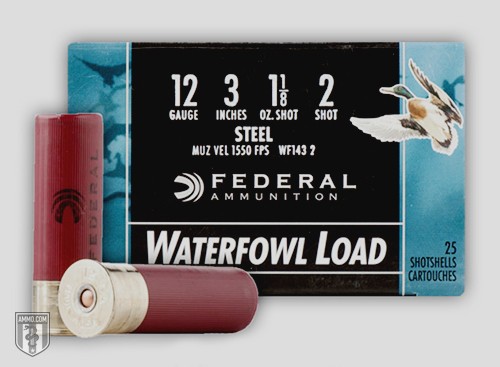#2 Steel Shot Ammo: #2 Steel Shot Explained
 With a smaller pellet diameter than all other sizes of buckshot, #2 shot grants you a larger number of pellets per shot. But even though #2 shot is a versatile ammo choice, it isn’t ideal for use when hunting deer, moose, bear or other large game. Most use steel shot for hunting waterfowl and predator control.
With a smaller pellet diameter than all other sizes of buckshot, #2 shot grants you a larger number of pellets per shot. But even though #2 shot is a versatile ammo choice, it isn’t ideal for use when hunting deer, moose, bear or other large game. Most use steel shot for hunting waterfowl and predator control.
Hunting Use
The #2 shot has long been a favorite of goose hunters due to the number of pellets and its ability to shoot a good pattern up to 40 yards. Many states and areas don’t like shooters using lead or have simply banned it outright because of the potential contamination of groundwater that could affect wildlife or residents in the area. And while this impact of lead ammunition on the environment is hotly debated, steel shot sizes offer a contaminant-free option.
That said, it sometimes can spread more than lead or be more unpredictable when fired. To counter this, check the pattern of your shotgun before going afield, as it is very possible that it will pattern differently than using lead shot. By doing this, you’ll be able to more accurately judge the effective range and spread – allowing you to be a more effective hunter. The firearms industry has begun to respond to the concerns of hunters and is using more advanced materials and designs in their ammunition to make steel shot a more palatable choice.
Home Defense
Many argue that shot sizes ranging from 00 to #4 buck are the only options for home defense, but #2 shot has several advantages. The higher pellet count allows for more wound channels and a decreased likelihood of over-penetration. Steel is slightly lighter than lead, which means steel may penetrate less into your target in a home-defense situation. This could lead to fewer accidents involving neighbors or people outside, should something get out of hand (#2 shot within 15 feet is still devastating).
Environmental Issues
For someone out shooting on their property or keeping coyotes down, steel or copper-plated lead is preferable to straight lead most of the time. A shot here and there of straight lead is nothing to worry about, but environmentalists claim that if you add up hundreds or thousands of rounds in your back yard and you have a well, you could be putting yourself at risk. This is the main reason lead is banned in certain forests and hunting grounds – as geese and ducks tend to be in watery areas.
#2 steel shot is a good overall choice for large birds, medium-sized mammals and home defense. The less dense and environmentally safer steel is quite popular, with the only downside being the loss of penetration with steel due to lead being heavier. By understanding the patterning, you will better understand the limitations of the load you are using. 12 gauge offers the widest variety of shot size and shell lengths, although you will be able to find it in most of the common gauges.
You can find the #2 shot size widely across the U.S., especially in popular duck and goose hunting locations. Just remember that large geese are much more difficult than they seem at first glance, so making the effort to purchase #2 steel shot is worth it – even if you need to order online.
Shotgun Projectiles
- #12 Lead Shot Ammo
- #9 Lead Shot Ammo
- #8.5 Lead Shot Ammo
- #8 Lead Shot Ammo
- #7.5 Lead Shot Ammo
- #7 Steel Shot Ammo
- #6 Lead Shot Ammo
- #6 Steel Shot Ammo
- #5 Lead Shot Ammo
- #5 Nickel-Plated Lead Shot Ammo
- #4 Lead Shot Ammo
- #3 Steel Shot Ammo
- #2 Steel Shot Ammo
- #4 Buck Ammo
- #3 Buck Ammo
- #1 Buck Ammo
- #1 Buck Rubber
- #0 Buck Ammo
- #00 Buck Ammo
- #000 Buck Ammo
- .4 Buck Ammo
- Rifled Slugs
- Sabot Slugs
